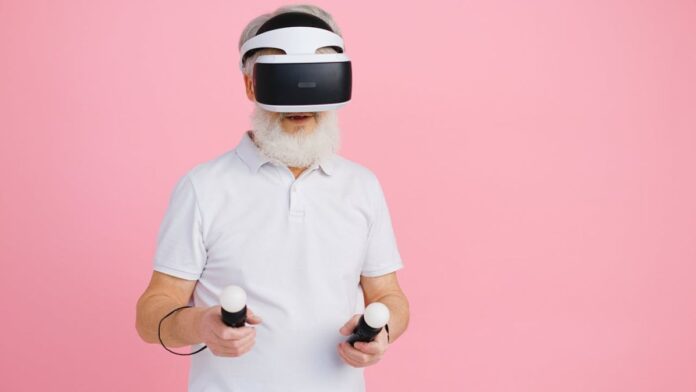A hallmark of advancing Parkinson’s disease is a distinctive shuffling walk. Dual-task training is an effective but costly physical therapy that helps people with Parkinson’s Disease to improve their gait and keep walking longer. A recent study published in Neurorehabilitation and Neural Repair showed that augmented reality (AR) headsets deliver effective virtual dual task training. This innovation opens the door to more accessible therapies for people living with Parkinson’s.
In this clinical trial, researchers found that practising with an AR headset was as good as a session with a physiotherapist. What’s more, participants were just as likely to stick with their training program.
What’s Parkinson’s Disease?
Parkinson’s Disease is the second-most common neurodegenerative disorder after Alzheimer’s, affecting nearly 500,000 Americans. Parkinson’s can lead to a variety of physical and cognitive symptoms that challenge independence and quality of life.
In Parkinson’s Disease, critical dopamine-producing neurons in a part of the brain that controls physical function, the substantia nigra, malfunction or die. Normally, dopamine works with other neurotransmitters to coordinate the nerve and muscle cells involved in movement. Without dopamine, the brain is unable to transmit signals normally to the body, and movement is impaired. This means as the disease progresses, people will find it harder to control their movements. This is especially significant when it comes to mobility.
Restricted Mobility
People with Parkinson’s experience loss of balance, shuffling gait, inability to swing the arms naturally, and “freezing” when trying to take a step. This makes walking very difficult. These symptoms get worse when a person with Parkinson’s tries to do more than one task at the same time. For example, problems with walking become worse if the person simultaneously tries to carry on a conversation. Finding ways to keep people living with Parkinson’s mobile and independent is a priority for researchers like Jay Alberts at the Cleveland Clinic.
How can Augmented Reality Help With Parkinson’s?
Dual-task training (DTT) is one strategy used to improve gait problems in PD. It works by challenging patients to manage multiple demands on their attention and coordination at the same time. For example, DTT might involve walking while simultaneously performing a task that requires concentration, like counting backward or solving a puzzle.
Dualiask therapy is normally done one-on-one with a physical therapist. The therapist creates a personalized program for each patient, coaches them through the exercises, and measures their progress. DTT can improve posture, balance and to prevent falls or “freezing” in people with Parkinson’s. Unfortunately, it is seldom used because of the time and cost involved. Innovations in augmented reality tech inspired Drs. Jay Alberts and Anson Rosenfeldt to take a novel approach to expanding access to DTT.
Futuristic Physical Therapy
Forty-seven participants with Parkinson’s-related gait problems were recruited into the study. The researchers randomly assigned the participants into one of two groups: the control group did DTT sessions led by an in-person therapist. The second group followed a program of Dual-Task Augmented Reality Treatment (DART). Both groups completed 16 therapeutic sessions over 8 weeks.

Instead of a human therapist, the DART program uses a digital avatar named Donna, named after Alberts’ mother. The user puts on the AR headset and sees Donna in their line of sight. The user then hears instructions through the headset while Donna demonstrates the exercises. The headset tracks the user’s movements and collects data for clinicians to review and use to design future sessions.
Putting Patients through their Paces
The DART program can create over 200 combinations of DTT exercises such as:
- Stepping forward when you hear an even number, stepping back on an odd number.
- Waving when a light is green, crouching when it’s red.
- Remembering a series of numbers while walking forward or navigating a digital obstacle course.
Both groups showed a comparable and significant improvement in their walking ability after the therapy. “[The DART program] can help us standardize and implement DTT,” said Jay Alberts in a press release, “The trial shows that using an AR headset or physical therapist directed DTT produces similar improvements in gait and postural stability.”
AR Not a Replacement for Physiotherapists
The authors caution that they do not intend for DART to take the place of physical therapists. Rather, it should provide a tool that will allow more patients to access DTT.
“People diagnosed with Parkinson’s disease often balance physical therapy, new medications and specialist appointments with their lives and families, which is overwhelming,” said Alberts. “Our goal is to make DTT more accessible, removing one more obstacle for patients who want to improve their daily lives.”
…………………..
References
Alberts JL, Kaya RD, Penko AL, et al. A Randomized Clinical Trial to Evaluate a Digital Therapeutic to Enhance Gait Function in Individuals With Parkinson’s Disease. Neurorehabil Neural Repair. 2023;37(9):603-616. doi:10.1177/15459683231184190
Using augmented reality to make Parkinson’s disease physical therapy more accessible. EurekAlert! Accessed March 13, 2024. https://www.eurekalert.org/news-releases/1001841
Parkinson’s Disease: Challenges, Progress, and Promise | National Institute of Neurological Disorders and Stroke. Accessed March 14, 2024. https://www.ninds.nih.gov/current-research/focus-disorders/parkinsons-disease-research/parkinsons-disease-challenges-progress-and-promise
Zheng Y, Meng Z, Zhi X, Liang Z. Dual-task training to improve cognitive impairment and walking function in Parkinson’s disease patients: A brief review. Sports Medicine and Health Science. 2021;3(4):202-206. doi:10.1016/j.smhs.2021.10.003



